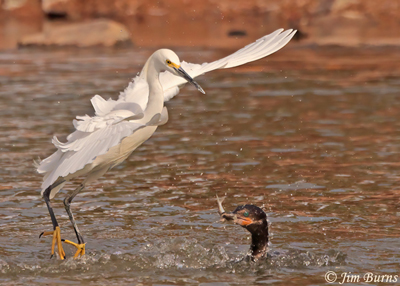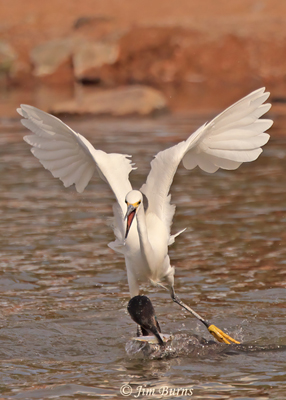
Every birder sooner or later realizes that birds are opportunists and their survival depends upon foraging with energy efficiency, but for me this raised a question one morning as I watched some riveting inter-specific action between several Snowies and a flotilla of Double-crested Cormorants at a fishing pond. On this day a handful of Snowies were standing on the rocks at the edge of the water intently watching as the cormorants quartered back and forth through the waters, diving and coming up with small fish.
This pond was 100 yards long and half that in width, and the moment a cormorant would emerge with a fish, one or more Snowies would launch, fly to the successful bird, and attempt to steal the catch by hovering and/or swooping onto it feet first. The attacked cormorant would submerge as it saw the egrets converging, and the action was frenetic, splashy, and only occasionally successful. It seemed to me that flying from the shore, often halfway across the pond and back, for minimal rewards couldn’t be as efficient as the Snowies doing their thing in shallow water, fishing by themselves.
Subsequently, a fairly thorough search through the literature failed to answer my question, but it turned up many fascinating “life hacks” employed by Snowy Egrets that were unbeknownst to me. Basically I went down a Snowy Egret “rabbit hole” and emerged with a greater appreciation for these common waders and a resolve to observe their behavior more closely and never be dismissive of them again.
There are many species about whose habits ornithologists still know very little. Snowy Egret is not one of them. The North American heron family employs thirty-four different foraging strategies that have been described and given a name. Birders often observe many of these without realizing each is an evolutionarily discrete behavior serving a distinct purpose tied to habitat, heron species, and prey species. Snowy Egrets display the broadest repertoire of any of our herons, employing twenty-one of the thirty-four behaviors, apparently because they have been proven to possess the best visual acuity of all our wading birds.
So, within their own large heron family, Snowies are unique! Unique, mostly self-explanatory, and just plain fun too, are the names of some of the different fishing behaviors of Snowy Egrets. Here is a partial list: standing; slow walking; quick walking; running; head swaying; tongue flicking; canopy feeding; and disturb and chase (akin to what mockingbirds do with their wing flashing). And, yes, four of the Snowies’ foot movement behaviors directly benefit from those bright “golden slippers,” one being the strategy birders most often observe—foot stirring.
Nonetheless, I could not find in my reading any mention of stealing from cormorants and, because the cormorants are quick to submerge with their catch if they see, or sense from experience, that Snowies will pounce if a fish appears, getting photographic evidence of what actually happens proved difficult. I would guesstimate the egret success rate was about one in twenty tries, and when a Snowy would come away with a fish I could never quite be sure whether it snatched the prey from the cormorant’s bill or scooped the catch from the water when the harassed owner lost its grip.
The little white herons’ visual acuity was on full display, though, because no matter how intently I concentrated on an individual cormorant’s activity, the vigilant Snowies were always in the air on their way to the attack before I could get the camera on the right spot. They were either seeing the fish itself or somehow sensing the cormorants’ success from the latters’ movements in the water before I could, and this greatly added to the difficulty of trying to document the actual point of attack and the tactics employed.
On several occasions as a successful cormorant submerged it appeared an egret would drop out of its hover, descend legs extended, feet first, and try to land literally on the diving cormorant’s back. And every now and then a successful egret would emerge from the splash and spray of the conflict with a fish in its bill. Between poor timing and the occlusion of the water, I was never able to capture the “gotcha” moment between Snowy and fish.
Obviously I need more practice, but even more obvious is that for Snowy Egrets this behavior is an evolutionarily tried and true foraging strategy. Next time you observe this action watch, enjoy, and marvel at the multitude of ways our fellow species have evolved to survive.